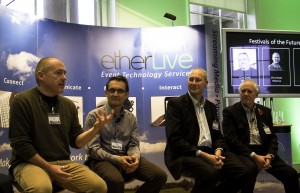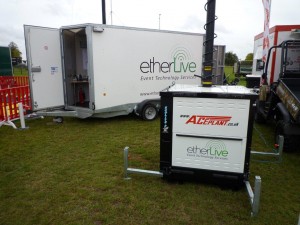As the summer of sport runs into the sunset suddenly the September of phones is upon us. Two big announcements means this is a really important month (and quarter) for a technology which has become intrinsic to either attending or producing events.
4G is Go? – Wait and See
After more manoeuvring than a telehandler placing toilets (see our previous blog posts) 4G services will finally begin deploying in the UK. The first to market will be Everything Everywhere (a combination of the Orange and T-Mobile networks) which announced on Tuesday networks firing up in London, Birmingham, Cardiff and Bristol within weeks with more cities expected to follow before Christmas. Long Term Evolution (or LTE) brings a number of significant improvements over current 3G networks including download speeds of up to 20Mbps, improved algorithms for handoff between mobile cells (which should mean less dropped calls) and in some cases larger cell sizes meaning better coverage.
It all sounds great, however, there should always be a note of caution when dealing with cellular services which is probably best expressed by matching todays “3G” experience with what happens in the real world. Do you live in a world where your handset always has 3G signal, you haven’t dropped a call in months, data use is reliable, network masts never fail and when you are trying to text or call the box office during a live event with 20,000 other people on site it works first time? – The answer is carriers always sell the dream of the next generation; 4G is exactly the same. In reality what you should expect to start with is what was promised for 3G, meaning OK to good data speeds in cities and calls which rarely drop. Also lest we forget 4G, like 3G before it, is a consumer focussed technology offering which means very little in the way of speed guarantees or service up time.
Of course unfortunately for events the same problems around delivering reliable service to a remote location with high density usage will continue to be a challenge – not helped by the next big thing in cellular this month…
iPhone 5 – A monster awakes.
You can’t have missed the press, Apple’s latest iPhone 5 was announced last night. Those in the know will point out that even with this latest incarnation Apples crown has slipped slightly with handsets from Samsung and Blackberry winning in the specification war but that’s missing two crucial factors which need to be considered when dealing with anything from Cupertino. The first is the tidal surge of press and activity that follows anything iNew generating floods of new apps and ways to use the device, many of which rely on the iPhones killer selling point; the lack of learning curve. The second is the new technology which is bound up in this latest generation which includes the ability to operate with the new 4G networks, a new screen to show that high definition content even clearer (which means larger network downloads and faster streams required) and an all new software pack which further integrates social networking and always on connectivity. In addition Apple has given the iPhone one of the best features of the iPad which is its ability to work on both 2.4Ghz networks and 5Ghz which makes getting a good Wi-Fi signal, and keeping it, even easier.
That reliance on faster and always on connectivity will continue to keep demand growing for events who can deliver apps which enjoy video and interactive content at events.
Where Apple has missed a trick perhaps is the lack of contactless payment function others (such as Samsung and Blackberry) have started to deploy this latest technology which will put pressure on retailers of all sorts to start supporting the quick payment method. Apple is probably waiting for the market to settle before setting out it’s stall (and – knowing Apple – where it’s revenue stream is going to come from) but those early adopters will expect to be using their contactless payment methods this summer – we have another blog in a few weeks on this and our activity over the summer.









